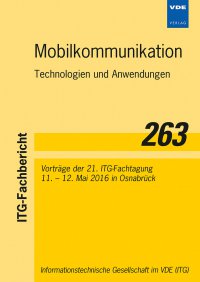End-user Benefits of LTE Dual Connectivity in Heterogeneous Networks
Conference: Mobilkommunikation – Technologien und Anwendungen - 21. ITG-Fachtagung
05/11/2016 - 05/12/2016 at Osnabrück, Deutschland
Proceedings: Mobilkommunikation – Technologien und Anwendungen
Pages: 5Language: englishTyp: PDF
Personal VDE Members are entitled to a 10% discount on this title
Authors:
Solano Arenas, John Camilo; Dudda, Torsten (Radio Research Germany, Ericsson, 52134 Herzogenrath, Germany)
Schmitz, Johannes; Mathar, Rudolf (Chair for Theoretical Information Technology, RWTH Aachen University, 52074 Aachen, Germany)
Abstract:
In response to the ever increasing traffic demand in mobile communication networks, e.g. LTE, features for radio resource aggregation are discussed. LTE Dual Connectivity (DC), standardized in 3rd Generation Partnership Project (3GPP) Release 12, is envisaged to improve the end-user performance by increasing the user throughput. This is achieved by aggregating resources from two separate eNBs operating on different carrier frequencies. In a heterogeneous network these eNBs are typically a Macro eNB providing large scale coverage, and a Pico eNB to boost capacity locally. The serving eNB can directly transmit a part of the buffered packets to the User Equipment (UE) while a second part is offloaded to a second eNB for transmission to the UE from there. We evaluate the end-user benefits of LTE DC in a realistic heterogeneous network deployment considering typical internet traffic types of today, e.g. webpage downloads. Our results show gains for the end-users with DC depending on the traffic type. This indicates that not only the achievable user throughput, but also the amount of data buffered in the eNBs and the latency dependency of the considered traffic determine the end-user experience. This work shows that DC is mostly beneficial when buffering in the eNBs occurs. Furthermore, for the worst users in the system, i.e. the cell edge users, DC enables to significantly reduce the webpage download times especially at medium system load. Therefore, DC can be considered an interesting feature to be added to LTE networks to cope with the increasing traffic demand of the upcoming years.


